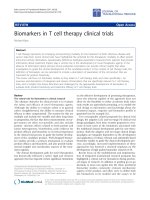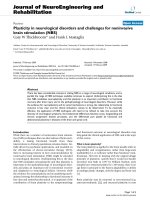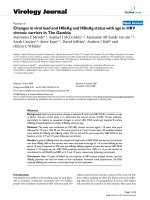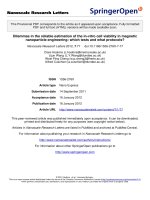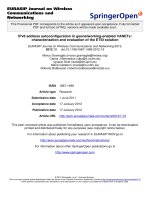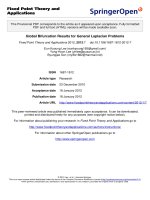Báo cáo toán học: " Localization in mobile wireless and sensor networks" pot
Bạn đang xem bản rút gọn của tài liệu. Xem và tải ngay bản đầy đủ của tài liệu tại đây (144.15 KB, 3 trang )
EDI T O R I A L Open Access
Localization in mobile wireless and sensor
networks
Monica Nicoli
1*
, Sinan Gezici
2
, Zafer Sahinoglu
3
and Henk Wymeersch
4
Accurate localization or tracking of wireless de vices is a
crucial requirement for many emerging location-aware
systems. Fields of applications include search and res-
cue, medical care, intelligent transportation, location-
based billing, security, home automation, industrial
monitoring and control, location-assisted gaming, and
social networking. During the last few years, there have
been intensive research activities in this area and various
solutions have been investigated. The main trend now is
toward the integration of heterogeneous technologies to
ensure global coverage and high accuracy in all possible
scenarios, leading to a seamless localization system
available anywhere anytime.
While satellite-based navigation is well consolidated
for open sky scenarios, localization in harsh environ-
ments (e.g., indoor or in urban canyons) is still an open
issue that requires complementary wireless networks.
Cellular systems, local/persona l area networks, ad hoc,
and wireless-sensor networks can be configured to sup-
port localization functionality. Indoor environments,
however, are particularly challenging because of severe
multipath and non-line-of-sight (NLOS) propagation. In
this context, advanced signa l processing algorithms
must be employed in order to guarantee positioning
robustness, such as NLOS ident ification and mitigation,
fusion of data from different sources, and Bayesian
methods to enclose any aprioriinformation (e.g.,
dynamic models for mobile positioning). An important
area of research is cooperative localization, which is
expected to significantly improve both accuracy and
coverage by exploiting all the available measurement s
on a peer-to-pe er basis; efficient protocols and proce-
dures have to be designed to minimize communication
overhead s and energy consumption. Measurement cam-
paigns are essential for calibrating signal models and
testing localization algorithms. A v aluable too l for
benchmarking algorithms is also provided by fundamen-
tal performance bounds, which are being actively ana-
lyzed as guidelines for t he design of efficient positioning
systems.
The objective of this special issue, which was pro-
moted under the auspices of the EC Network of Excel-
lence in Wireless Communications NEWCOM++ (in
particular, the Work Package WPR.B on Localization
and Positioning Techniques), was to gather recent
advan ces in both signal processing and communications
areas, for localization in mobile wireless and sensor net-
works. Articles were solicited on both experimental and
theoretical aspects, including new positioning algorithms
and methodologies, system design and configurat ion,
performance analysis and measurement campaigns.
We received a total of 56 manuscripts addressing the
above issues and challenges, of which 16 were selected
for publication. Selection of each article was the result
of a careful assessment by at least two (mostly three)
independent reviewers with expertise on localization and
wireless networking. Articles went through a minimum
oftwotoamaximumoffourrevisionphasesbefore
acceptance. Accepted articles belong to four main
research areas: integratio n of positioning and communi-
cation functionalities, robustness to NLOS errors, indoor
positioning, and localization in wireless sensor networks
(WSNs).
The first group of articles deals with the interaction of
positioning and communications at different layers of
the protocol stack. Connectivity issues are studied in
Gao et al., which considers the relation between distance
and communication hops, accounting for the border
effect and dependence problems, for a model that is
more realistic than the traditional unit-disk graph
model. A related problem is i nvestigated in the study of
Moragrega et al., which deals with location-awa re clus-
ter formation. The authors propose LACFA, a distribu-
ted network formation algorithm that significantly
increases the probability of localization of sensors in a
cluster-tree topology. On the physical layer, Schmeink et
* Correspondence:
1
Dipartimento di Elettronica e Informazione, Politecnico di Milano, Milan,
Italy
Full list of author information is available at the end of the article
Nicoli et al. EURASIP Journal on Wireless Communications and Networking 2011, 2011:197
/>© 2011 Nicoli et al; licensee Springer. This is an Open Access article distributed under the terms of the Creative Commons Attribution
License ( which permits unrestricted use, distribution, and reproduction in any medium,
provided the original work is properly cited.
al. propose a channel parameter estimator for joint com-
munications and positioning systems, using soft infor-
mation concerning the parameter estimates. On the
network layer, Kong et al. tackle the problem of localiza-
tion and link detection for location-aware routing, with
particular emphasis on NLOS links. The authors c om-
plement their theoretical work with an experimental
evaluation with commercial transceivers, operating in
the 2.4 GHz ISM band.
The second group of articles f ocuses on the challen-
ging task of localization with high position accuracy in
NLOS environments. Huang et al. deriv e the Cramér-
Rao lower bound (CRLB) for WSN localization when
position coordinates of the reference devices are subject
to errors. They use a non-parametric kernel method to
estimate the probability density function of the NLOS
errors. The provided CRLBs can also be applicable to
LOS cases after setting the NLOS error to zero. In
another article, Mallat et al. propose two time-of-arri val
estimators and show that the estimators achieve the
baseband CRLB. A positioning algorithm that is robust
to NLOS links is des cribed in the article by Gholami et
al. The authors first discuss the properties of projection
onto convex sets (POCS) and outer approximation (OA)
techniques for us e in positioning, and then de velop di s-
tributed positioning algorithms based on POCS and OA.
Improvement of coverage and accuracy performance,
especially in NLOS scenar ios, can be provided by coop-
eration among nodes. In the article by Eren, graphical
conditions that lead to unique localizability in coopera-
tive networks with hybrid distance and bearing measure-
ments are determined. The author also shows that the
localization problem is solvable in linear time, and it is
possible to reduce the required number of sensing links.
The next group of articles shifts the focus on localiza-
tion in indoor environments. New techniques based on
received signal strength (RSS) are presented, placing the
emphasis on calibration of pathloss models and digital
maps on experimenta l data. More specifically, Vanheel
et al. present a test-bed for indoor localization in WSNs
using RSS lateration. An automated method is proposed
for calibration of the pathloss model and pre-processing
of measured data in order to optimize the lo calization
performance. The article by Oussar et al. deals with
localization of GSM devices in domestic or offi ce envir-
onment s using a very large database of RSS fingerprints.
Machine learning techniques are employed to extract
the location information from online RSS measurements
showing promising performance for room-level classifi-
cation. The use of differential radio maps is proposed by
Wang et al. to mitigate the effects of dynamic environ-
ments and accommodate different receiver gains. Parti-
cle filters (PFs) are employed to track moving targets
using observation likelihoods obtained from the
differential radio maps. Next two articles extend the
analysis of Baye sian filtering with new results for indo or
navigation. The first one, by Kaiser et al., presents a new
motion model for pedestrians wit h a p riori information
on maps and floor plans. The model is derived from a
diffusion algorithm that makes use of the principle of a
source effusing gas and is exploited by a PF tracker for
improving navigation performance. The second article,
by Dhital et al., investigates experimentally the suitability
of a number of Bayesian filtering te chniques for i ndoor
positioning by ultrawide band networks. The article also
highlights the robustness of the cost-reference PF to
model inaccuracies. Fina lly, the article by Callaghan et
al. studies the feasibility of localization of a set of wire-
less nodes in a rich-scattering environment using signals
received from ambient sources, without any knowledge
of sources locations and transmitted waveforms. Pair-
wise distances are derived from cross correlations of the
received signals using statistical methods assisted by
multi-dimensional scal ing. Tests on both simulated and
real measurements in an office environment show locali-
zation accuracy of about 2 m.
The last two articles, by Gustafsson et al. and Xaver et
al., investigate localization algorithms for WSNs. In the
first article, RSS-based localization is studied for realistic
situations in which neithe r the emitted power nor the
power law decay exponent are known. The authors first
validate a model in the logarithmic scale, which is linear
in the unknown nuisance parameters. Then, they
develop a localization algorithm based on this model.
The proposed algorit hm can be useful in rapidly
deployed networks consisting of a number of sensor
nodes w ith low-bandwidth communications. In the sec-
ond article, decentralized localization of an acoustic
source is studied in a sensor network based on the
underlying partial differential equation. An algorithm is
proposed for the localization o f multiple acoustic
sources by employing decentralized particle filtering,
which exploits the sparsity of the matrices in t he state-
space model. Also, a version of the maximum consensus
algorithm is used to aggregate local posterior distribu-
tions from the clusters.
We would like to thank the authors of all submitted
articles for considering our special issue for dissemin at-
ing their study. We are also very grateful to the numer-
ous reviewers who provided valuable and timely
feedback to the authors. Their efforts were very helpful
in improving the quality of the accepted articles. We
would also like to thank the staff of Hindawi and
SpringerOpen for their valuable assistance through the
entire editing process, and the Editor-in-Chief of the
journal, Prof. Luc Vandendorpe, for trusting us with this
important assignment and helping us fulfil it success-
fully. Last but not least, we thank the members of
Nicoli et al. EURASIP Journal on Wireless Communications and Networking 2011, 2011:197
/>Page 2 of 3
NEWCOM++ for their collaboration in submitting high-
quality articles to this special issue.
Monica Nicoli
Sinan Gezici
Zafer Sahinoglu
Henk Wymeersch
Author details
1
Dipartimento di Elettronica e Informazione, Politecnico di Milano, Milan,
Italy
2
Department of Electrical and Electronics Engineering, Bilkent University,
Ankara, Turkey
3
Mitsubishi Electric Research Labs, Cambridge, MA, USA
4
Department of Signals and Systems, Chalmers University of Technology,
Gothenburg, Sweden
Received: 23 August 2011 Accepted: 6 December 2011
Published: 6 December 2011
doi:10.1186/1687-1499-2011-197
Cite this article as: Nicoli et al.: Localization in mobile wireless and
sensor networks. EURASIP Journal on Wireless Communications and
Networking 2011 2011:197.
Submit your manuscript to a
journal and benefi t from:
7 Convenient online submission
7 Rigorous peer review
7 Immediate publication on acceptance
7 Open access: articles freely available online
7 High visibility within the fi eld
7 Retaining the copyright to your article
Submit your next manuscript at 7 springeropen.com
Nicoli et al. EURASIP Journal on Wireless Communications and Networking 2011, 2011:197
/>Page 3 of 3


